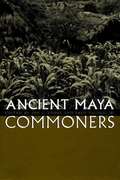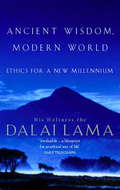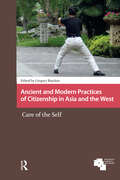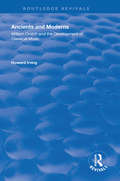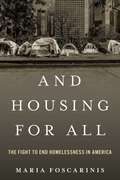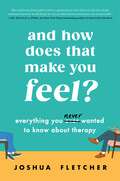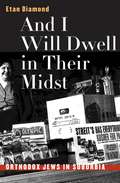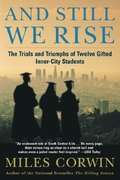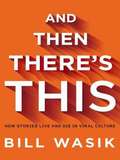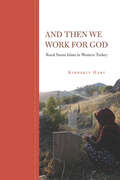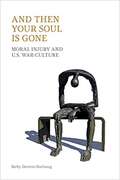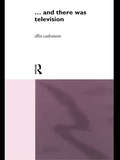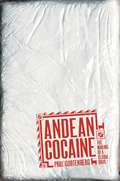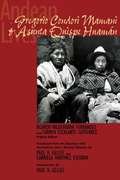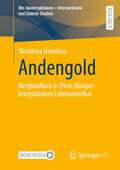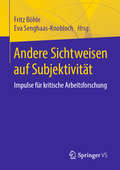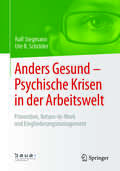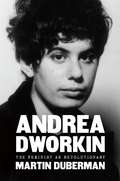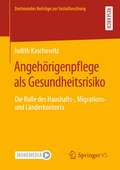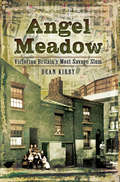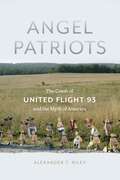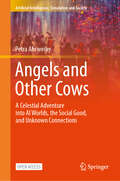- Table View
- List View
Ancient Maya Commoners
by Jon Lohse Fred ValdezMuch of what we currently know about the ancient Maya concerns the activities of the elites who ruled the societies and left records of their deeds carved on the monumental buildings and sculptures that remain as silent testimony to their power and status. But what do we know of the common folk who labored to build the temple complexes and palaces and grew the food that fed all of Maya society? This pathfinding book marshals a wide array of archaeological, ethnohistorical, and ethnographic evidence to offer the fullest understanding to date of the lifeways of ancient Maya commoners. Senior and emerging scholars contribute case studies that examine such aspects of commoner life as settlement patterns, household organization, and subsistence practices. Their reports cover most of the Maya area and the entire time span from Preclassic to Postclassic. This broad range of data helps resolve Maya commoners from a faceless mass into individual actors who successfully adapted to their social environment and who also held primary responsibility for producing the food and many other goods on which the whole Maya society depended.
Ancient Wisdom, Modern World: Ethics for the New Millennium
by The Dalai Lama Alexander NormanAt a time and in a culture where science and technology have taken over from religious belief, when ethics are understood primarily in terms of aesthetic choice or legality, how are we to formulate moral principles to guide us in our daily lives? Though religion can certainly help in this, the Dalai Lama demonstrates that there are universal principles we can draw on which transcend the dilemma of belief or unbelief. And whilst many have been content to speak of spiritual matters as something mysterious or evanescent, the Dalai Lama explains his approach in terms that are as clear and concise as they are compelling. With wit, gentle good sense and with penetrating insight, the Dalai Lama shows how the truths that have stood the test of generations of practise can provide us with the tools to live happy, fulfilled and meaningful lives. In the process, it becomes apparent that he does not merely espouse the 'feelgood' religiosity some accuse him of. The reader is left admiring not just the wisdom of the author, but the wisdom of the culture he represents.
Ancient Wisdom, Modern World: Ethics for the New Millennium
by Alexander Norman His Holiness The Dalai LamaAt a time and in a culture where science and technology have taken over from religious belief, when ethics are understood primarily in terms of aesthetic choice or legality, how are we to formulate moral principles to guide us in our daily lives? Though religion can certainly help in this, the Dalai Lama demonstrates that there are universal principles we can draw on which transcend the dilemma of belief or unbelief. And whilst many have been content to speak of spiritual matters as something mysterious or evanescent, the Dalai Lama explains his approach in terms that are as clear and concise as they are compelling. With wit, gentle good sense and with penetrating insight, the Dalai Lama shows how the truths that have stood the test of generations of practise can provide us with the tools to live happy, fulfilled and meaningful lives. In the process, it becomes apparent that he does not merely espouse the 'feelgood' religiosity some accuse him of. The reader is left admiring not just the wisdom of the author, but the wisdom of the culture he represents.
Ancient and Modern Practices of Citizenship in Asia and the West: Care of the Self (Asian Cities)
by Gregory BrackenWhat does it mean to be a good citizen today? What are practices of citizenship? And what can we learn from the past about these practices to better engage in city life in the twenty-first century? Ancient and Modern Practices of Citizenship in Asia and the West: Care of the Self is a collection of papers that examine these questions. The contributors come from a variety of different disciplines, including architecture, urbanism, philosophy, and history, and their essays make comparative examinations of the practices of citizenship from the ancient world to the present day in both the East and the West. The papers' comparative approaches, between East and West, and ancient and modern, leads to a greater understanding of the challenges facing citizens in the urbanized twenty-first century, and by looking at past examples, suggests ways of addressing them. While the book's point of departure is philosophical, its key aim is to examine how philosophy can be applied to everyday life for the betterment of citizens in cities not just in Asia and the West but everywhere.
Ancient and Modern: William Crotch and the Development of Classical Music (Routledge Revivals)
by Howard IrvingFirst published 1999, Howard Irving details Croch’s lecturing career and examines the influences of figures such a Charles Burney and Sir Joshua Reynolds on his approach to the ancient-modern debate. Irving also makes available for the first time in a modern edition Crotch’s 1818 lecture series. These texts help to fill a gap in our knowledge of the development of musical classics, as they span a period of years that were crucial to the history of canon formation.
And Housing for All: The Fight to End Homelessness In America
by Maria FoscarinisA groundbreaking legal advocate argues that only by recognizing housing as a fundamental human right can we hope to solve America&’s homelessness crisis. In And Housing for All, founder of the National Homelessness Law Center Maria Foscarinis reveals the human impact of the housing crisis by sharing personal stories and examining the flawed policies that have perpetuated it. As millions face rising housing costs and encampments spread nationwide, she uncovers why past efforts have failed and what must change to achieve lasting solutions. Drawing from over 35 years of national advocacy, Foscarinis shares compelling stories of individuals and families impacted by homelessness, highlighting their resilience and growing leadership. Blending personal narratives with policy analysis, she reveals how deliberate decisions have fueled the crisis and how public narratives have sustained it.And Housing for All is essential reading for social justice advocates, policymakers, lawyers, and anyone invested in solving one of America&’s most pressing challenges.
And How Does That Make You Feel?: Everything You (N)ever Wanted to Know About Therapy
by Joshua FletcherPsychotherapist Josh Fletcher takes us on a tour of the inner mind of a therapist—revealing a hilariously candid point of view on the therapeutic process, a practical guide to therapy, and maybe a few more cobwebs and dark corners than one might expect. It’s everything you ever wanted to know about therapy (and maybe a few things you didn’t). Trauma, heartbreak, anxiety, and mourning are all parts of the human experience, and Josh Fletcher’s mission in life is to normalize the need to find a trusted professional with whom you can discuss all of life’s scariest aspects. Through the lens of four of his patients—Daphne, a wildly successful actor who still struggles to find contentment; Levi, an intimidating bouncer with obsessive tendencies who’s trapped in a sex cult; Zahra, an anxious, people-pleasing doctor in the midst of unpacking serious trauma; and Noah, a shy newcomer with some major closet skeletons—you’ll share in their self-discovery and recovery as they untangle themselves from an all-too-familiar web of emotions. In between sessions, Fletcher struggles to balance his own well-being with that of his patients as details from his sometimes messy but always heartfelt personal life reveal that therapists aren’t immune to getting tripped up by the same hurdles as the rest of us. And How Does That Make You Feel? is a primer on what to expect from therapy, how to find the right therapist, and the most common afflictions treated in therapy (such as depression, OCD, and panic attacks) as well as a darkly hilarious narrative about what’s going on in your therapist’s mind before, during, and after your session. Above all, it’s filled with the promise that a better future is always possible . . . if we’re willing to seek help and do the work.
And I Will Dwell in Their Midst
by Etan DiamondSuburbia may not seem like much of a place to pioneer, but for young, religiously committed Jewish families, it's open territory." This sentiment--expressed in the early 1970s by an Orthodox Jew in suburban Toronto--captures the essence of the suburban Orthodox Jewish experience of the late twentieth century. Although rarely associated with postwar suburbia, Orthodox Jews in metropolitan areas across the United States and Canada have successfully combined suburban lifestyles and the culture of consumerism with a strong sense of religious traditionalism and community cohesion. By their very existence in suburbia, argues Etan Diamond, Orthodox Jewish communities challenge dominant assumptions about society and religious culture in the twentieth century.Using the history of Orthodox Jewish suburbanization in Toronto, Diamond explores the different components of the North American suburban Orthodox Jewish community: sacred spaces, synagogues, schools, kosher homes, and social networks. In a larger sense, though, his book tells a story of how traditionalist religious communities have thrived in the most secular of environments. In so doing, it pushes our current understanding of cities and suburbs and their religious communities in new directions.
And Slowly Beauty
by Michel Nadeau Maureen LabontéEverything changes on what begins as a typical day in the life of the aptly named Mr. Mann, a forty-eight-year-old, buttoned-down, middle management type in a pinstriped grey suit, who feels himself losing touch with his job, his wife, his children, and the rest of his urban life. He wins tickets to a production of Chekhov's Three Sisters and realizes that the mid-life cocoon he has spun around himself is beginning to unwind.And Slowly Beauty, first performed in French in 2003, was created collaboratively by Michel Nadeau and colleagues from his Quebec troupe, Théâtre Niveau Parking. With the intensity of an electric current striking a reflecting pool, Nadeau shows us how Chekhov's century-old drama about the yearning of three sisters in a dreary provincial town directly addresses Mann's own stifled existence and liberates him from his self-imposed "gulag."Mann returns to see Three Sisters a second time, finding that its themes of beauty and poetry lost to the monotony of everyday existence mirror many aspects of his own existence. At the same time, Mann's dying friend realizes that he is for the first time able to appreciate the astonishing beauty of trees outside his window. The irony of such a deathbed admission is not lost on Mr. Mann.With Chekhov's characters and themes coming to inhabit the protagonist's mind and life, emphasized by the repeated image of geese flying overhead - these birds do not question the purpose of their journey but find it sufficient to fly in unison - And Slowly Beauty speaks eloquently to the power of art to transform lives.Cast of 3 women and 3 men.
And Still We Rise (The Trials and Triumphs of Twelve Gifted Inner-City Students)
by Miles CorwinHe was yet another victim of a drive-by shooting, a teenage boy splayed out on a South-Central Los Angeles street corner, with several gunshot wounds to the chest. He died before the paramedics arrived. The two homicide detectives could find no wallet and no identification on the boy, so the coroner's investigator called him John Doe Number 27. Bestselling author of The Killing Season and veteran Los Angeles Times reporter Miles Corwin spent a school year with twelve high school seniors -- South-Central kids who qualified for a gifted program because of their exceptional IQs and test scores. Sitting alongside them in classrooms where bullets were known to rip through windows, Corwin chronicled their amazing odyssey as they faced the greatest challenges of their academic lives. And Still We Rise is an unforgettable story of transcending obstacles that would dash the hopes of any but the most exceptional spirits.
And Then There's This
by Bill WasikBreaking news, fresh gossip, tiny scandals, trumped-up crises-every day we are distracted by a culture that rings our doorbell and runs away. Stories spread wildly and die out in mere days, to be replaced by still more stories with ever shorter life spans. Through the Internet the news cycle has been set spinning even faster now that all of us can join the fray: anyone on a computer can spread a story almost as easily as The New York Times, CNN, or People. As media amateurs grow their audience, they learn to think like the pros, using the abundant data that the Internet offers-hit counters, most e-mailed lists, YouTube views, download tallies-to hone their own experiments in viral blowup. And Then There's Thisis Bill Wasik's journey along the unexplored frontier of the twenty-first century's rambunctious new-media culture. He covers this world in part as a journalist, following "buzz bands" as they rise and fall in the online music scene, visiting with viral marketers and political trendsetters and online provocateurs. But he also wades in as a participant, conducting his own hilarious experiments: an e-mail fad (which turned into the worldwide "flash mob" sensation), a viral website in a month-long competition, a fake blog that attempts to create "antibuzz," and more. He doesn't always get the results he expected, but he tries to make sense of his data by surveying what real social science experiments have taught us about the effects of distraction, stimulation, and crowd behavior on the human mind. Part report, part memoir, part manifesto, part deconstruction of a decade, And Then There's Thiscaptures better than any other book the way technology is changing our culture.
And Then We Work for God: Rural Sunni Islam in Western Turkey
by Kimberly HartTurkey's contemporary struggles with Islam are often interpreted as a conflict between religion and secularism played out most obviously in the split between rural and urban populations. The reality, of course, is more complicated than the assumptions. Exploring religious expression in two villages, this book considers rural spiritual practices and describes a living, evolving Sunni Islam, influenced and transformed by local and national sources of religious orthodoxy. Drawing on a decade of research, Kimberly Hart shows how religion is not an abstract set of principles, but a complex set of practices. Sunni Islam structures individual lives through rituals—birth, circumcision, marriage, military service, death—and the expression of these traditions varies between villages. Hart delves into the question of why some choose to keep alive the past, while others want to face a future unburdened by local cultural practices. Her answer speaks to global transformations in Islam, to the push and pull between those who maintain a link to the past, even when these practices challenge orthodoxy, and those who want a purified global religion.
And Then Your Soul Is Gone: Moral Injury And Us War-culture
by Kelly Denton-Borhaug Equinox PublishingThe sharp and unforgiving suffering of the morally injured veteran cannot be fully understood, much less effectively addressed, without a comprehensive investigation of moral injury's underlying causes in American culture and society. This book exposes the threads of violence that tie together the naturalized dynamics of U.S. ways of war and militarization with collective practices of national distraction and self-deception. It shows how these same threads of violence are also tightly woven and sacralized in the tapestry of U.S. national identity, tragically concealing moral injury from greater consciousness, and sourcing its toxic growth - ironically - in the very lives of those the nation claims it most highly esteems, our military service members and veterans. Drawing on Claudia Card's philosophical framework, moral injury here is characterized as an atrocity, "a foreseeable intolerable harm caused by culpable wrongdoing." These atrocities are shown to be flash-points revealing important truths regarding the unlivable consequences of U.S. war-culture and highlighting the urgent need to rethink the meaning of U.S. nationalism, desacralize violence, and support life.
And There Was Television
by Ellis Cashmore Professor Ellis CashmoreWhy all the fuss over television? It is blamed for an assortment of evils, including violence, shortened attention spans, the decline of literacy and political indoctrination. In this scintillating and approachable book, Ellis Cashmore weighs up the theories and evidence. He argues that much of the panic is without foundation and that the single most important danger posed by TV is that it encourages us to spend too much. Cashmore agrees with many writers that television is an elemental force in today's culture, but he offers us a completely different account of how and why this has come about. It is an evaluation that will surprise, provoke and delight. In essence, Cashmore argues that television is the central apparatus of consumer society and its success is measured not in terms of whether we enjoy programs, but how much we spend as a result of watching them. It is a book that should be read by anyone who watches television and wants to know what it is doing to them.
Andean Cocaine
by Paul GootenbergIlluminating a hidden and fascinating chapter in the history of globalization, Paul Gootenberg chronicles the rise of one of the most spectacular and now illegal Latin American exports: cocaine. Gootenberg traces cocaine's history from its origins as a medical commodity in the nineteenth century to its repression during the early twentieth century and its dramatic reemergence as an illicit good after World War II. Connecting the story of the drug's transformations is a host of people, products, and processes: Sigmund Freud, Coca-Cola, and Pablo Escobar all make appearances, exemplifying the global influences that have shaped the history of cocaine. But Gootenberg decenters the familiar story to uncover the roles played by hitherto obscure but vital Andean actors as well--for example, the Peruvian pharmacist who developed the techniques for refining cocaine on an industrial scale and the creators of the original drug-smuggling networks that decades later would be taken over by Colombian traffickers. Andean Cocaine proves indispensable to understanding one of the most vexing social dilemmas of the late twentieth-century Americas: the American cocaine epidemic of the 1980s and, in its wake, the seemingly endless U.S. drug war in the Andes.
Andean Lives
by Paul H. GellesGregorio Condori Mamani and Asunta Quispe Huamán were runakuna, a Quechua word that means "people" and refers to the millions of indigenous inhabitants neglected, reviled, and silenced by the dominant society in Peru and other Andean countries. For Gregorio and Asunta, however, that silence was broken when Peruvian anthropologists Ricardo Valderrama Fernández and Carmen Escalante Gutiérrez recorded their life stories. The resulting Spanish-Quechua narrative, published in the mid-1970s and since translated into many languages, has become a classic introduction to the lives and struggles of the "people" of the Andes. Andean Lives is the first English translation of this important book. Working directly from the Quechua, Paul H. Gelles and Gabriela Martínez Escobar have produced an English version that will be easily accessible to general readers and students, while retaining the poetic intensity of the original Quechua. It brings to vivid life the words of Gregorio and Asunta, giving readers fascinating and sometimes troubling glimpses of life among Cuzco's urban poor, with reflections on rural village life, factory work, haciendas, indigenous religion, and marriage and family relationships.
Andengold: Bergbaufluch in (Post-)Bürgerkriegsländern Lateinamerikas ((Re-)konstruktionen - Internationale und Globale Studien)
by Dorothea HamiltonDer 2016 unterschriebene Friedensvertrag mit FARC in Kolumbien stellt das Land u.a. vor die Frage, welche Bedeutung der Ressourcenreichtum des Landes für den Aufbau einer friedlichen Gesellschaft spielen soll. Abgeleitet von den Erkenntnissen aus Peru wird untersucht, welchen Einfluss der legale und nicht legale Abbau von Gold auf die jeweiligen bewaffneten Konflikte hatte, wie sich deren Nutzung in der Friedenszeit wandelte und welche neuen Konflikte entstanden sind. Zum Umgang mit der ehemaligen Konfliktressource Gold gibt es divergierende Vorstellungen, die extraktivistischen und postextraktivstischen Ideen zugeordnet werden können, die in lokalen Konflikten enden. Der Fokus liegt auf der subnationalen, nach Abbauart differenzierten Untersuchung von Ressourcenausbeutung und Bürgerkrieg bzw. Postbürgerkrieg. Die Ergebnisse zu illegalem Bergbau zeigen, dass es sich dabei nicht um ein Bürgerkriegsphänomen handelt, sondern vielmehr um eine geduldete Praxis, die die Bewaffnung von Gewaltakteuren bedingt. Aber auch legale Ressourcenförderung, die nach Beendigung des Konflikts als Strategie der Friedensfinanzierung verstanden wird, führt zu ähnlichen negativen Auswirkungen, sodass von einem Bergbaufluch gesprochen wird.
Andere Sichtweisen auf Subjektivität: Impulse für kritische Arbeitsforschung
by Fritz Böhle Eva Senghaas-KnoblochDer Wandel von Arbeit, der als Subjektivierung und Digitalisierung diskutiert wird, hat unerwartete Folgen: Mehr Selbstverantwortung schafft noch keine befreite Welt der Erwerbsarbeit, und Technik dringt in die Domänen geistiger Arbeit ein. Der Band versammelt Analysen aus soziologischer, psychologischer und psychoanalytischer Sicht und beleuchtet Subjektivität in der Erwerbsarbeit mithilfe verschiedener theoretisch-konzeptioneller Zugänge. Das Ziel ist, einen neuen Bezugsrahmen für kritische Arbeitsforschung zu bilden.Der InhaltErfordert der Wandel von Arbeit eine neue Sicht auf Subjektivität? Zur Einführung • Humane Arbeit als geistige Arbeit? • Relationale Subjektivität in subjektivierten Arbeitsverhältnissen • Wie brauchbar sind rollentheoretische Konzeptionen in flexibilisierten Arbeits- und Lebenswelten? • Aus der Subjektivierungsfalle zum handlungsfähigen Akteur – Das Versprechen der Aktionsforschung • Herrschaftsverhältnisse und Wissensformen – Kritische Betrachtung eines Umbruchs bei der Wissensvermittlung in Unternehmen • Die Grenzen instrumenteller Verfügbarkeit von Subjektivität – Einsichten aus der Arbeitswelt der Pflege • Entfremdung und Aneignung in der Arbeit • Subjekt-Objekt-Relationen in der Sozialisation, in der Arbeit und im AlltagDie HerausgebendenFritz Böhle, Prof. Dr., Universität Augsburg und Institut für sozialwissenschaftliche Forschung e.V. München.Eva Senghaas-Knobloch, Prof. Dr., Universität Bremen, interdisziplinäres Forschungszentrum Nachhaltigkeit (artec).
Anders Gesund – Psychische Krisen in der Arbeitswelt: Prävention, Return-to-Work und Eingliederungsmanagement
by Ralf Stegmann Ute B. SchröderDas Buch behandelt das Thema psychische Gesundheit im Betrieb von der Pr#65533;vention und Fr#65533;herkennung bis hin zur R#65533;ckkehr in den Betrieb nach einer psychischen Krise. Es zeigt M#65533;glichkeiten zu einem umfassenden Return-to-Work Ansatz, der die Bedingungen f#65533;r eine professionelle Koordination und erfolgreiche Begleitung der zur#65533;ckehrenden Mitarbeiter beschreibt. Return-to-Work ist mehr als ein Betriebliches Eingliederungsmanagement (BEM). Return-to-Work (RTW) umfasst die Vernetzung von betrieblichen Schl#65533;sselakteuren, behandelnden #65533;rzten und Therapeuten und ist integraler Bestandteil der Therapie. Im Mittelpunkt steht dabei das Selbstmanagement der Zur#65533;ckkehrenden. Der RTW-Prozess wird praxisnah anhand eines Vier-Phasen-Modells der Wiedereingliederung beschrieben.
Andrea Dworkin: The Feminist As Revolutionary
by Martin DubermanFifteen years after her death, Andrea Dworkin remains one of the most important and challenging figures in second-wave feminism. Although frequently relegated to its more radical fringes, Dworkin was without doubt a profoundly influential writer, thinker, and activist--a formidable, brilliant, and uncompromising public figure who inspired and infuriated in equal measure. Her detractors were eager to reduce her to the caricature of the angry, man-hating feminist who believed that all heterosexual sex was rape, and as a result, her work has long been misunderstood. It is only in recent years, especially with the emergence of the #MeToo movement, that there has been a resurgence of interest in her ideas. Given exclusive access to Dworkin's massive and previously closed archives, award-winning biographer Martin Duberman traces Dworkin's life, from her brutal mistreatment after being arrested for protesting against the Vietnam War and her abusive first marriage through her central, crusading role in the sex and pornography wars of the following decades that sharply divided the feminist movement and continue to reverberate to this day. With a keen eye to how her prolific writing fits into her life and into the history and politics of the time, this is a vital and long-overdue reassessment of the life and work of one of the towering and most complex figures in feminist history. MARTIN DUBERMAN is Distinguished Professor Emeritus of History at the CUNY Graduate Center, where he founded and for a decade directed the Center for Lesbian and Gay Studies. The author of more than twenty books--including Paul Robeson, Stonewall, The Worlds of Lincoln Kirstein, A Saving Remnant, Howard Zinn, Hold Tight Gently, and Has the Gay Movement Failed?--Duberman has won a Bancroft Prize and been a finalist for both the National Book Award and the Pulitzer Prize. Duberman has also won the Lifetime Achievement Award from the American Historical Association, an honorary Doctor of Humane Letters from Amherst College, and an honorary Doctor of Letters from Columbia University.
Angehörigenpflege als Gesundheitsrisiko: Die Rolle des Haushalts-, Migrations- und Länderkontexts (Dortmunder Beiträge zur Sozialforschung)
by Judith KaschowitzDie Versorgung pflegebedürftiger Angehöriger ist eine der wichtigsten Aufgaben unserer Zeit. Unklar ist, ob damit Gesundheitsverschlechterungen für informell Pflegende verbunden sind. Diese Arbeit geht unter Zuhilfenahme europäischer Längsschnittdaten (Survey of Health, Ageing and Retirement in Europe und English Longitudinal Study of Ageing) der Frage nach, ob informelle Pflege mit negativen Gesundheitsfolgen verbunden ist. Dabei wird berücksichtigt, dass mögliche Gesundheitsfolgen in Abhängigkeit des Ortes (innerhalb oder außerhalb des eigenen Haushalts) und Landes der Pflegeübernahme sowie der Herkunft der Pflegenden variieren können. Im Ergebnis zeigt sich, dass Pflegekonstellationen mit einer großen (emotionalen/räumlichen) Nähe zwischen Pflegenden und Gepflegten sowie in Ländern mit geringem formellen Pflegeangebot besonders belastend sind. Keine Unterschiede in den Gesundheitsfolgen von informeller Pflege zeigen sich dagegen in Abhängigkeit des Herkunftskontexts, sprich Migrationshintergrundes. Die Ergebnisse machen sozialpolitischen Handlungsbedarf bei der Unterstützung Pflegender deutlich und zeigen auf, dass Wohlfahrtsstaaten Rahmenbedingungen schaffen sollten, gesundheitsschonende Angehörigenpflege zu ermöglichen.Die AutorinJudith Kaschowitz ist als Post-Doktorandin an der TU Dortmund am Lehrstuhl für Sozialstruktur und Soziologie alternder Gesellschaften tätig. Sie forscht empirisch quantitativ und international vergleichend zu Fragestellungen im Bereich der Alterns- und Gesundheitssoziologie.
Angel Meadow: Victorian Britain's Most Savage Slum
by Dean Kirby“A record of how a city of great wealth ignored the desperate poverty at its very heart . . . It is a lesson in the price of capitalism.” —North West Labour History Journal“It is all free fighting here. Even some of the windows do not open, so it is useless to cry for help. Dampness and misery, violence and wrong, have left their handwriting in perfectly legible characters on the walls.” —Manchester Guardian, 1870Step into the Victorian underworld of Angel Meadow, the vilest and most dangerous slum of the Industrial Revolution. In the shadow of the world’s first cotton mill, 30,000 souls trapped by poverty are fighting for survival as the British Empire is built upon their backs. Thieves and prostitutes keep company with rats in overcrowded lodging houses and deep cellars on the banks of a black river, the Irk. Gangs of “scuttlers” stalk the streets in pointed, brass-tipped clogs. Those who evade their clutches are hunted down by cholera, typhoid and tuberculosis. Lawless drinking dens and a cold slab in the dead house provide the only relief from a filthy and frightening world.In this shocking book, journalist Dean Kirby takes readers on a hair-raising journey through the gin palaces, alleyways and underground vaults of this nineteenth-century Manchester slum considered so diabolical it was re-christened “hell upon earth” by Friedrich Engels.ENTER ANGEL MEADOW IF YOU DARE . . . “In this book the author expertly achieves driving home the grim horror that was Angel Meadow. These were conditions at the bottom of human endurance and conditions that go beyond imaginations of modern-day citizens.” —Crime Traveller
Angel Patriots: The Crash of United Flight 93 and the Myth of America
by Alexander T. RileyWhen United Flight 93, the fourth plane hijacked in the September 11, 2001 terrorist attacks, crashed into a field near Shanksville, Pennsylvania, the gash it left in the ground became a national site of mourning. The flight’s 40 passengers became a media obsession, and countless books, movies, and articles told the tale of their heroic fight to band together and sacrifice their lives to stop Flight 93 from becoming a weapon of terror. In Angel Patriots, Alexander Riley argues that by memorializing these individuals as patriots, we have woven them into much larger story of our nation—an existing web of narratives, values, dramatic frameworks, and cultural characters about what it means to be truly American. Riley examines the symbolic impact and role of the Flight 93 disaster in the nation’s collective consciousness, delving into the spontaneous memorial efforts that blossomed in Shanksville immediately after the news of the crash spread; the ad-hoc sites honoring the victims that in time emerged, such as a Parks Department-maintained memorial close to the crash site and a Flight 93 Chapel created by a local Catholic priest; and finally, the creation of an official, permanent crash monument in Shanksville like those built for past American wars. Riley also analyzes the cultural narratives that evolved in films and in books around the events on the day of the crash and the lives and deaths of its “angel patriot” passengers, uncovering how these representations of the event reflect the myth of the authentic American nation—one that Americans believed was gravely threatened in the September 11 attacks. A profound and thought-provoking study, Angel Patriots unveils how, in the wake of 9/11, America mourned much more than the loss of life.
Angels and Other Cows: A Celestial Adventure into AI Worlds, the Social Good, and Unknown Connections (Artificial Intelligence, Simulation and Society)
by Petra AhrweilerThis open access novel uses fantasy and romance to pique readers' interest in understanding how AI technologies can be used for social justice across very different political and social terrains. Can you truly reach out to somebody who is in every aspect the direct opposite of yourself? Gabriel and Tilda, the two protagonists of this futuristic novel, are very different people. They work at a Berlin-based international aid company, and the only thing they can agree on is that the world is in a shambles: Scarce public resources, conflict and crises, inequalities, religious and socio-cultural belief systems that cement social injustice, have created a world as deeply divided and set apart as Gabriel and Tilda. They are sent on company business to recruit international partners for a social development project on global justice, and start travelling the world together. On their adventurous journey through many countries, they learn about the impacts of culture on social welfare systems, while trying to define their own relationship, which is intermingled with generational power games and milieu-specific worldview struggles. In Gabriel and Tilda’s attempts to bridge the deep gulf between their personalities, the novel creates a metaphor for finding a cohesive model of global justice using artificial intelligence that can integrate highly contextualized, national value cultures. Gabriel and Tilda are supported by two guardian angels: Assigned to save the planet through interpersonal and intercultural integration, the angels GA and TA team up with English Benedictine monk and mystic guru Bede Griffiths who is very keen to help Tilda and Gabriel in their model pilot of unlikely love.
Angels of a Lower Flight: One Woman's Mission to Save a Country . . . One Child at a Time
by Susie Scott KrabacherThe inspiring story of how one woman's message of hope and opportunity will change the lives of an entire generation. Three schools, two orphanages, a hospital, and an abandoned-infant home -- constructed in the poorest country in the western hemisphere -- were the result of one quick television commercial. The ad was for a charity, asking for donations to help impoverished children in a third world country. Though author Susie Scott Krabacher had a little money to give, what she wanted was to hold the hand of every child she saw and tell them that they were not forgotten and that they too were important. When Susie called the charity, it wanted only monetary donations -- and every other overseas nonprofit she contacted couldn't or wouldn't take on an inexperienced volunteer. So Susie set out to change the children's lives on her own. In this heartbreaking and inspiring memoir, Susie Scott Krabacher tells how the pain in her past caused her to doubt if God really loved and protected her. From her abusive childhood to her experiences as a Playboy centerfold during the 1980s, Susie details with frank honesty how she lost her faith along the way and how her experiences helping children in Haiti, an impoverished nation only five hundred miles from Florida, brought God back into her life. In a country where 10 percent of all children die before the age of four, Susie mounted a brave effort to provide not just charity but opportunity. By treating the children she helps as individuals, Susie gives them the tools to save their own country. Although some of the children she's tirelessly worked to rescue do not survive, Susie will never again lose her faith.
